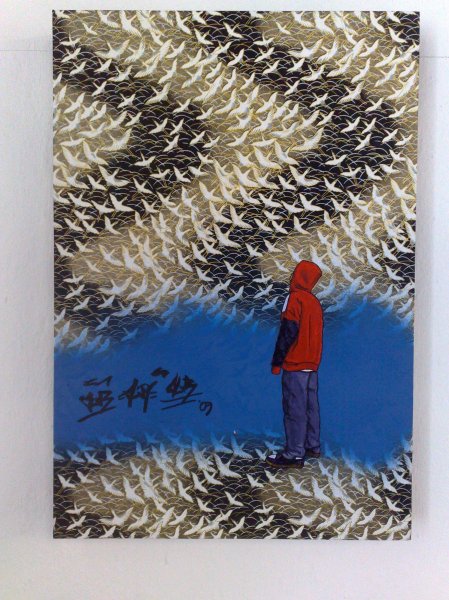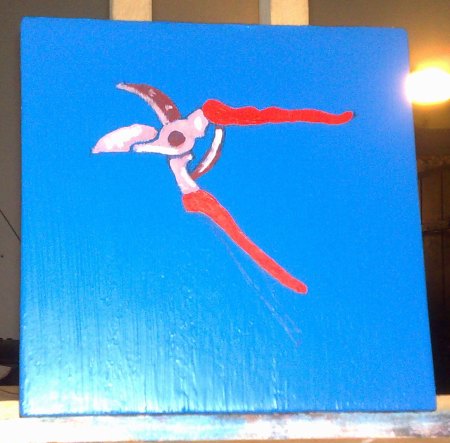
Continuing my ongoing series of posts which are partially a review of Hans Abbing’s brilliant book “Why Are Artists Poor?”, I’d like to talk about the concept of the artists as the “gifted individual”.
It’s fairly obvious that most people view artists, musicians and writers as being talented or exceptional, and I would suggest that the hysteria around a certain recently deceased mega-celebrity bears this out. I would also go further and suggest that this couples with the idea that the work of art is some kind of mystical object or moment that transports you to elevated heights – be it a painting, a poem of a piece of music. Artists therefore tend to have a higher status than their professional peers, regardless of how successful he or she might be., and it’s true in my experience that people display a degree of excitement and sometimes jealousy that I’m an artist (Abbing also says that the host of any party he may attend will often take great delight in introducing him to his friends as an artist – more so than if he says he’s an economist!)
Another quote:
“…over the last one hundred and fifty years artists and the arts have become symbols of an alternative to the bourgeois lifestyle. It was a romantic, not a realistic alternative; and this probably added to its allure. Since Romanticism, society has worshipped authentic and sacred art.
Art consumers often try to identify with one or more of their favourite artists. By listening to their works or by surrounding themselves with their works they share a little of the artist’s uniqueness. Artists are adored. In the market, this tends to lead to extremely high prices as well as high incomes for a very small select group of artists.”
However, Abbing shows that this idea is fundamental to how the economy of the arts keeps most artists in actual poverty (even taking into account the 2nd jobs, and financial support from their families, as well as government subsidies, grants and donations, the result is still actual poverty).
The key is at the end of the last quote, regarding the “high incomes for a very small select group of artists.” The idea that no price is too high to pay for such mystical heights keeps prices high, but in a celebrity obsessed culture where Damien Hirst et al are hugely financially successful and renowned, wannabe artists sign up for art college in their droves, hoping for a shot at immortality or fame, hoping that they can be one of the “winner-takes-all” crowd. The reality is that there are far too many artists:
“…’mental shelf-space limitations’ also contribute to the emergence of winner-takes-all markets. Earlier I spoke of a ‘limited star capacity’ . This means that people tend to remember the relevant details of only a limited number of products such as product names or the names of its authors. Otherwise, a consumer’s life becomes unnecessarily complicated and unpleasant. It generally pays to remember the names of artists who are already renowned. By listening to others one can save on so-called search costs. Moreover, being familiar with the same artists adds to the pleasure of communicating about them with others. For the average art consumer it makes sense to limit one’s energies to a small number of already famous artists. The ‘limited star capacity’ of consumers helps explain the astronomical incomes that some artists fetch.”
Abbing then goes on to offer some killer explanations as to why incomes are low in the light of this. he expounds them in greater details, but in summary:
“1. The Winner-takes-all principle: Winner-takes-all markets are important in the arts. They attract many competitors.
2. Unfitness for other profession: Because artists believe they are unfit for other, non-art professions, they believe they are better off in the arts despite the low income.
3. An orientation to non-monetary rewards; (a) The average artist is more interested in non-monetary rewards than other professionals, while (b) such rewards are (thought to be) available in abundance in the arts.
4. An inclination to take risks: (a) the average artist is less risk-aversive than other professionals, while (b) high stakes, in the form of both non-monetary and monetary income, are (thought to be) available in abundance in the arts.
5. Overconfidence and self-deceit: more than other professionals, the average artist is inclined to over-estimate his or her skills and luck and at the same time, ignore available information; therefore they overestimate the rewards available to them in the arts.
6. Wrong information; the average artist is less well informed than other professionals; therefore they overestimate the rewards available to them in the arts.”
If you are an artist of any stripe, I’d now like to throw another quote at you, but I would advise you to sit down and pour yourself a stiff drink first. Ready? Here goes:
“..the overwhelming majority of artworks end up in a garbage dump. This might happen in part during an artist’s lifetime and in part shortly after his or her death. Within fifty years of an artist’s death, some ninety percent of his or her manuscripts, scores, compositions, and paintings have disappeared into the rubbish bin. These are averages of course. A rather small selection of artists still has its work intact but for the vast majority, their work has all but vanished. (..also worth noting is the fact that…) of all the works hung on walls in the Netherlands during the Golden Age, less than one percent have survived to the present day.”
You can be the most gifted, talented individual, you can work tirelessly, devoted to your craft, with determination and zeal, but not only is there no guarantee that it will pay off in the long run, it’s extremely likely that it won’t.
The number of times that I’ve read or heard even people that I respect in the arts say: “You just need to believe in yourself and work hard, and everything will be fine’ or somesuch similar nonsense, it makes me want to throttle them on the spot. This is patently not true. Of course you need self-belief and determination, but to suggest that these things alone will get you a successful art career is at best irresponsible, at worst deliberately cruel. But then, I suppose that “successful artists” have an interest in maintaining their position by peddling this rubbish.
The reality is that gifted or talented as you may be, you need to realise that it can be a curse as much as a gift, and sometimes the price you pay is one of economic disadvantage. And there’s nothing romantic about that.
So assuming that you’ve made your peace with this, that I haven’t depressed you too much, and that you have balls of brass and want to carry on anyway, there’ll be another post along in this series soon.

















